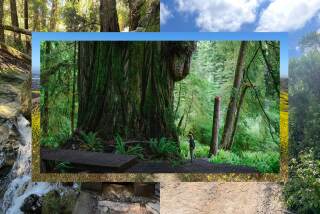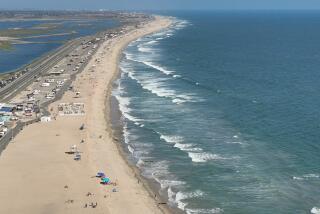Hidden Wonders
You’ve probably passed the Carpinteria Salt Marsh while driving along the 101 Freeway between Ventura and Santa Barbara. You may have glanced toward the ocean and noted railroad tracks fronting the flat wetlands of the marsh.
At first glimpse, the flat terrain with stubby plantings and little variation in color seems a gloomy wasteland, a shabby second cousin to gleaming sand beaches where tide pools vibrate with life and ocean waves splash and foam.
But get inside and the marsh works its magic, becoming ever more beautiful as closer investigation reveals its complexity and diversity.
A marsh, like a bog or a swamp, is one of the Earth’s soggy zones, the low places periodically or seasonally moist or flooded. Marshes develop in lowlands such as flood plains and muddy deltas of rivers and creeks where drainage is poor. Salt marshes form along the ocean coastline, frequently near shallow lagoons, particularly those sheltered by sandbars or barrier islands.
Because of the delicate balance between tidal salt water and nutrient-rich fresh water, salt marshes support a large variety of animal and plant life. They serve as breeding grounds for waterfowl, fish and other wildlife. For some endangered species, such as the salt marsh bird’s beak plant and the light-footed clapper rail, the marsh is the last stronghold.
The Carpinteria Salt Marsh, which has garnered much attention for the last 20 years as one of the few estuaries that remain in Southern California, is accessible to the public, thanks to a restoration project that includes the Carpinteria Marsh Park.
Upon arriving at the marsh, our small group was met by Wayne Ferren, manager of the marsh reserve and associate director of the UC Santa Barbara Natural Reserve System. Ferren explained that the marsh is an estuarine trough covering 230 acres at the base of the Santa Ynez Mountains.
No plants grow in the sloping areas of the marsh where large patches of highly salty mud predominate. And, at first glance, the plants that do grow elsewhere in the marsh seem less than spectacular.
Dave Hubbard, an expert on the plants of the marsh, described the variables--frequency of flooding, depth of water, salinity and length of submergence--that determine where plants grow. These plants often have to contend with a salt concentration as high as 10%.
Salt-tolerant plants, known as halophytes, don’t absorb much water but have thick, leathery leaves to retain the water they have. Plants at the mud fringes, such as glasswort and sea blite, can tolerate high salinity because they excrete excess salt from their shoots.
Others, such as sea lavender and narrow-leafed ice plant, shed excess salt with their leaves. Holding up an ice plant, Hubbard explained, “This plant sequesters salt in the epidermal cells of the leaves. When it dies, the salt released by rain results in a high-salinity dead zone. Look how there are no plants growing around it.”
What do these scientists like showing students in the K-12 education program who visit the marsh?
“I love showing them the marsh channels during incoming tides, especially in summer when sharks and stingrays enter,” Ferren said. “They love watching the sharks that come into the estuary to eat crabs, and the rays that come in to eat clams and to mate.”
The marsh is at or near the limit of the northwestern geographic range for many species, including Belding’s savannah sparrow and the light-footed clapper rail. Cormorants, grebes and pelicans can be spotted off the coast. The estuary is important both for resident species, including shorebirds (marbled godwits), wading birds (great blue herons), gulls, terns and passerines (Belding’s savannah sparrows); and for migratory and seasonal use by long-billed curlews, least terns, snowy plovers and other species.
These migratory birds gorge themselves on fish or invertebrates before flying on to South America or the Arctic Circle, depending on the season. During winter migration, as many as 2,000 shorebirds have been recorded at the marsh in a single day.
Bird-watchers come to the marsh in July seeking the clapper rails. These birds are easiest to spot at evening high tide when they perch on the pickle-weed-covered sand hillocks, silhouetted by moonlight to the east or the setting sun to the west. Upland areas provide roosting for raptors. Cooper’s and red-tailed hawks, black-shouldered kites and ospreys are also visitors to the marsh.
This estuary is filling in with sediment after 9,000 years of interaction with humans. This is why the scientists are working to preserve the biologically important ecosystem of the marsh.
Their reasons range from the ecological to the academic to the poetic. As much as anything, they want generations of visitors to be able to enter a seemingly monochromatic flatland and discover the vibrant palette of life and color within.
BE THERE
Carpinteria Salt Marsh: For a tour that includes a full day of nature exploration, visit the salt marsh display at the Santa Barbara Museum of Natural History or its Sea Center at the Santa Barbara Harbor. For information on the Carpinteria Salt Marsh, contact UC Santa Barbara Natural Reserve System at the Marine Science Institute, UC Santa Barbara, (805) 893-4127. For information about Carpinteria Marsh Park, call Bob Nisbet, (805) 684-5405, Ext. 402.
More to Read
Sign up for The Wild
We’ll help you find the best places to hike, bike and run, as well as the perfect silent spots for meditation and yoga.
You may occasionally receive promotional content from the Los Angeles Times.






